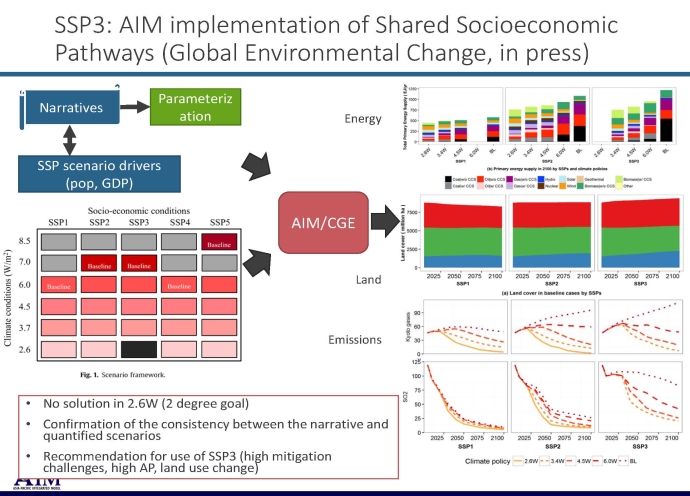論文情報
著者:S.Fujimori, T.Hasegawaa, T.Masui, K.Takahashi, D.S.Herran, H.Dai, Y.Hijioka, M.Kainuma
掲載年:2016
雑誌名:Global Environmental Change(In Press)
◆論文へのリンク
キーワード
SSPs; Socioeconomic scenarios; AIM; Computable general equilibrium model; Integrated assessment model; Climate mitigation
概要
This study quantifies the Shared Socioeconomic Pathways (SSPs) using AIM/CGE (Asia-Pacific Integrated Assessment/Computable General Equilibrium). SSP3 (regional rivalry) forms the main focus of the study, which is supposed to face high challenges both in mitigation and adaptation. The AIM model has been selected as the model to quantify the SSP3 marker scenario, a representative case illustrating a particular narrative. Multiple parameter assumptions in AIM/CGE were differentiated across the SSPs for quantification. We confirm that SSP3 quantitative scenarios outcomes are consistent with its narrative. Moreover, four key features of SSP3 are observed. First, as SSP3 was originally designed to contain a high level of challenges to mitigation, mitigation costs in SSP3 were relatively high. This results from the combination of high greenhouse gas emissions in the baseline (no climate mitigation policy) scenario and low mitigative capacity. Second, the climate forcing level in 2100 for the baseline scenarios of SSP3 was similar to that of SSP2, whereas CO2 emissions in SSP3 are higher than those in SSP2. This is mainly due to high aerosol emissions in SSP3. A third feature was the high air pollutant emissions associated with weak implementation of air quality legislation and a high level of coal dependency. Fourth, forest area steadily decreases with a large expansion of cropland and pasture land. These characteristics indicate at least four potential uses for SSP3. First, SSP3 is useful for both IAM and impact, adaptation, vulnerability (IAV) analyses to present the worst-case scenario. Second, by comparing SSP2 and SSP3, IAV analyses can clarify the influences of socioeconomic elements under similar climatic conditions. Third, the high air pollutant emissions would be of interest to atmospheric chemistry climate modelers. Finally, in addition to climate change studies, many other environmental studies could benefit from the meaningful insights available from the large-scale land use change resulting in SSP3.
*画像をクリックすると拡大されます





